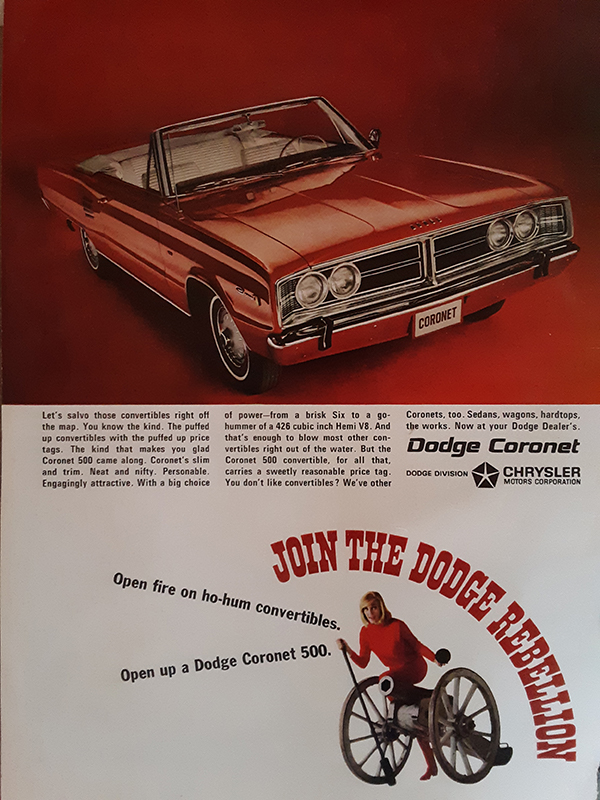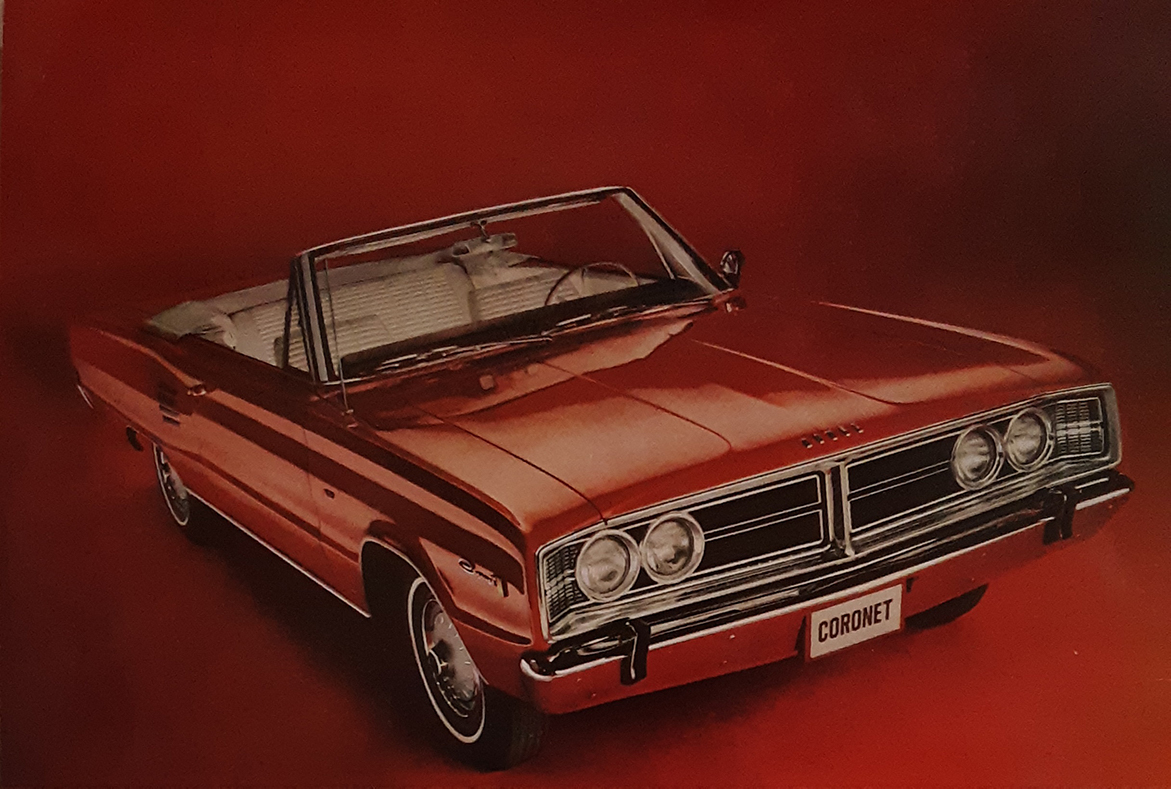Pages From The Past: Go-Hummer … the 1966 Street HEMI® Arrives!
The Dodge Rebellion! The 426 Street HEMI® engine-powered vehicle! An all-new, totally redesigned Coronet lineup! 1966 was a big year for Dodge and this ad touting a fresh Coronet 500 convertible proves the point.

Conjured with assistance from Batten, Barton, Durstine & Osborn (BBD&O), Dodge’s advertising agency, the Dodge Rebellion ad campaign encompassed the entire Dodge lineup, which consisted of the compact Dart at the bottom, the big Polara and Monaco at the top and – in the middle – the mid-sized Coronet and Charger.
While the Charger was truly unique with its fastback body and hideaway headlamps, it was the Coronet that carried the ball with the masses in the mid-sized sales field. All new with crisp folds and profuse delta-themed lines, Coronet was available in just about every conceivable body configuration. You could get a two-door business sedan, two-door hardtop, four-door sedan, station wagon and – as featured in this magazine ad – a slick convertible.

What’s more, for the first time ever, the mighty, Daytona-conquering 426 HEMI engine was available in any Coronet body style except station wagons, and as this ad makes very clear, Dodge wanted very much to sell you a HEMI engine-powered Coronet convertible. The copy says: “Let’s salvo those convertibles right off the map. You know the kind. The puffed up convertibles with the puffed up price tags. The kind that makes you glad the Coronet 500 came along … With a big choice of power – from a brisk Six to a go-hummer of a 426 cubic inch Hemi V8. And that’s enough to blow most other convertibles right out of the water.”

Let’s take a moment to absorb the meaning of it all. Remembering that Chrysler Corporation devised the 426 HEMI engine in 1964 specifically to win the Daytona 500 and thus reinvigorate the spirit of excitement via the trickle-down theory of “win on Sunday, sell on Monday”, the engine was expensive to build and Chrysler wasn’t planning on making more than a few hundred a year – to be used by sanctioned racers to promote the brand. Dodge really didn’t expect, or want, to sell a bunch of HEMI engines. The idea was to “bait and switch” showroom visitors into a mass-produced engine, perhaps a 325-horsepower 383 4-barrel with enough suds to satisfy most right feet.
But when NASCAR’s rule-makers decreed the HEMI engine to be not stock-enough for stock car racing, Chrysler was forced to put into semi-mass production starting in 1966. Off came the exotic cross-ram intake manifold, down went the compression ratio from 12.5 to 10.25:1 and cam timing was mellowed a bit. But otherwise, the stuff that made the 426 HEMI engine an instant legend remained, including the (understated by 50) 425 horsepower rating.
And so it was that 1966 – the debut year for the 426 Street HEMI – was by far the year with the highest number of Street HEMI engine-powered vehicle sales in the “Elephant”’s 1964 to 1971 production run. In 1966, a total of 2,729 Street HEMI engine-powered passenger cars were built and sold. The next highest Street HEMI production output came in 1968, with 2,391 units. For contrast, 1969 yielded 1,702; 1970 yielded 1,543; 1967 yielded 1,234; and 1971 – the HEMI’s final year – yielded a mere 356.
Of the 2,729 Dodge and Plymouth Street HEMI engine-powered vehicles unleashed in 1966, just 27 came in drop top Dodge convertible models like the one featured in this magazine ad. Of them, 6 were Coronet 440s and 21 were Coronet 500s. The difference between the Coronet 440 and Coronet 500 had nothing to do with engine size (the 440 and 500 don’t reference the engine at all), rather the 500 was the sportiest of the lot, with standard front bucket seats, added trim inside and out, and specific wheel covers.

But is the sleek red Coronet 500 drop top featured in the ad one of the legendary 425 horsepower HEMI engine-powered vehicles? A quick glance at the small metal emblem behind the front wheel opening tells the tale. The small logo reads “V8”, a signal that a 230-horse 318 polyspherical head V8, a 265-horse 361 big block with a single 2-barrel carburetor or a 270-horse 383 big block – again with a single 2-barrel carburetor – is under the hood. To be considered a HEMI car, we’d need to see the distinctive “426 Hemi” emblems in place (a “383 Four Barrel” emblem would have signaled the 325-horse 383 with a single Carter 4-barrel).
And that’s the catch. Unlike competing “muscle cars” where their makers added special image-making details – like fake hood scoops, styled steel wheels, paint stripes and go-fast names – for 1966, Dodge let the music do the talking. That would change in 1967 with the introduction of the Coronet R/T (and Plymouth’s GTX). But for 1966, if you didn’t pay close attention to the small metal front fender emblems, you just might get HEMI’d!

0 Comments